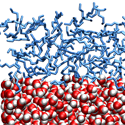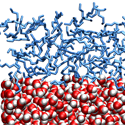Small-scale hydraulics
Biology is rife with examples of fluids flowing through tiny spaces, such as blood surging through a capillary or water transporting nutrients across the porous membrane of a cell. In such exceptionally narrow channels, the orientation of the molecules in the fluid can determine the rate, and even the mechanism of flow.
Taking a cue from biology, scientists are now designing nanofluidic devices in which molecular interactions at the walls of a narrow channel are engineered to control fluid flow. With this motivation in mind, Douwe Jan Bonthuis, Dominik Horinek, Lydéric Bocquet, and Roland Netz at Technische Universität München in Germany are exploring the problem of how static and rotating electric fields can affect the motion of a dipolar liquid, like water, when it is confined to a nanochannel.
Writing in Physical Review Letters, they base their calculations on a generalization of the Navier-Stokes equation—the fundamental equation to describe fluid mechanics—by taking into account the rotational motion and relaxation of water molecules and the boundary conditions at the surface of the nanochannel.
In contrast to earlier predictions, they find that applying a static electric field parallel to the interface will not cause fluid flow. However, a rotating electric field can generate vorticity at the interface that leads to a net motion of water.
Bonthuis et al.’s work suggests one way to convert electric energy into fluid flow at the nanoscale. It is also of interest for understanding electro-osmotic effects where ions in solution aggregate toward a charged wall and can drag fluid in the presence of an external electric field. – Jessica Thomas





